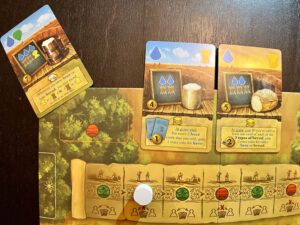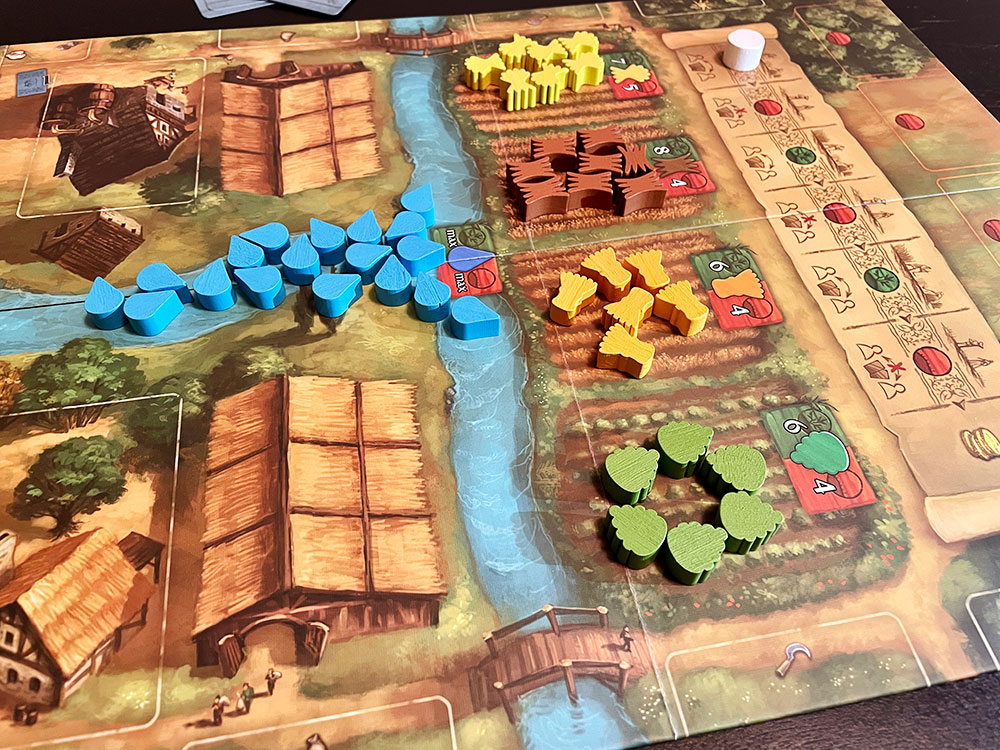 Can entire villages survive on a constant diet of the titular offerings of Beer & Bread? How would the people stay productive as they grew sleepy, and their bodies gained weight? Would their health deteriorate to a point that the town doctor would need to expand their practice? And what percentage of the population is dipping their bread INTO the beer?
Can entire villages survive on a constant diet of the titular offerings of Beer & Bread? How would the people stay productive as they grew sleepy, and their bodies gained weight? Would their health deteriorate to a point that the town doctor would need to expand their practice? And what percentage of the population is dipping their bread INTO the beer?
The title and setting of the newest offering from designer Scott Almes and publisher Capstone Games sets the tone and has us asking all kinds of questions. Why are the two villages so close together? Will they combine into one mega-corporation to take over the world of brew and loaf? And are we selling our crafted creations to each other across the river? Are there outsiders who visit the local monastery, and do they come for our goods? Is this game creating an emergent narrative out of a simple two-player structure?
So much to ponder. I need a drink.
Gameplay Overview:
Beer & Bread is a two-player game featuring multi-use cards and a unique round structure. The objective is to craft beer and bread using collected resources, but the amount you can craft is restricted to only one good per type. This is further complicated by the nature of final scoring: both good types are scored separately, and you retain the lowest of the two.

As such, this is a game of diversification and efficiency. Players must work to keep their production of the two good types even in scoring to obtain the best possible final score. Play occurs over six years which alternates between fruitful and dry. Players begin the game with five cards. The main board is seeded with the indicated amount of resource types (wheat, barley, rye, hops) and water is abundant.
Before we get into round structure, let’s discuss the multi-use card actions. Cards can be used in one of three ways during a turn: Harvest and Store, Produce and Sell, and Upgrade and Clean. Harvesting provides resources, producing allows players to craft goods with gained resources, and upgrading provides powerful abilities and clears out the goods that have been produced (remember, you can only store one of each type at a time).

During fruitful years, after the field is seeded properly and players have drawn five cards, players play one card each and then swap hands. This happens for all five cards before the round is over. During dry years, players pick up any cards they used to harvest the previous round then draw back up to five cards. Three cards are also added to an exchange area, which is used by both players during the year. Also, there are fewer resources seeded into the fields.
When harvesting a card, players gain the resources that are featured at the top. Harvesting again allows players to stack the cards and provides the resources on the new card as well as any in the matching columns above it. Harvested resources are added to a limited storage of nine spaces. The overflow of inventory goes to your opponent if they have space.
The final item I’ll mention is the upgrade system. Each card you add to your upgrade area pertains to a specific section of the board. You can add cards that trigger when you clear your goods, or that pertain to field resources, storage additions, or producing goods. There’s also phase specific and end game scoring options too. There are no limits on these areas, so you can have as many upgrades as you choose in each area.

Game Experience:
Make no mistake, Beer & Bread is a quality little two-player game. It plays in about thirty to forty-five minutes, provides plenty of variability via the inclusion of multi-use cards, and is quite simple to setup and tear down. Yet it isn’t a light experience and provides plenty of challenging decisions as cards don’t find their way back to you or you can’t quite get resources to line up with available production space.
My favorite part of this system is the alternating years and the way they change the flow. One moment you’re swapping cards back and forth, the next you’re stuck with your hand and only three cards in an exchange area to consider for a swap. This rotating structure makes planning a little more difficult and keeps strategy just out of arms reach at times. If there’s any issue in this portion of the game, it would be trying to keep in mind the cards that you’ve swapped during fruitful years.

Another interesting part of the structure is the fact that at the start of a dry year, you get to pick up any cards you used for harvesting the previous year. This doesn’t happen upon the transition from dry to fruitful, which makes the dry years a prime moment to customize potential production or upgrades. It can be a little hard to navigate the space for efficiency, but some cards may even be good to harvest two years in a row.
The restriction of only allowing one beer and one bread to be produced at a time prior to clean up is a nice wrinkle. It lends itself to the diversification of final scoring, but it also requires a strategy for resource collection and goods availability. It’s most efficient to play an upgrade card when both slots are filled, but this isn’t always possible as card options dwindle over the course of each year. Thankfully upon game end you still get to keep the goods produced even if they’ve not been added to the clean-up piles.

The storage overflow is also a fun thematic inclusion. The setting is two villages across the river from each other and while there is competition, it feels friendly enough. So why not share the wheat and hops you’re about to throw out with your neighbors? This can be a bit punishing when you’re not paying attention, giving your opponent ample supplies for their next production. But crafty players will be keeping an eye on the opposite storage levels and strike when the competition is unable to capitalize.
Areas of Beer & Bread that set this back slightly are focused around two very specific elements. First, even with a draw deck that has only two good types, the luck of the draw does come into play. I wonder what this game would’ve looked like with two separate draw piles (one of each good type), providing the ability to have a little more freedom of choice. Second, it almost feels like the game is one round too short. Scores remain tight with six years, but I can’t imagine them getting too out of balance with a little more time.
Final Thoughts:
And so, in the end, we answered none of the questions that were heavy on our minds in the introduction, but we did come away with a new appreciation for designer Scott Almes. This small box game has found a way to enliven the two-player design space. Beer and Bread feels like a mini-Euro tribute but provides enough twists and turns to be worthy of your most refreshing mug of ale and a nice cut off of that golden brown bread. Beer & Bread is easy to teach, fun to play, and is going to stay in the collection for a while longer.
Final Score: 4 stars – Deftly balances the design space between alternating rounds, multi-use cards, and quality goods production.
 Hits:
Hits:
• Multi-use cards
• Overproduction resource sharing
• Dual round structure
• Fast setup/teardown
• Final scoring twist
Misses:
• Possible draw issues and luck
• One round too short?
• Fruitful year drafting





















